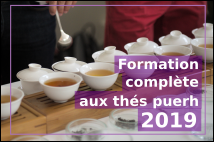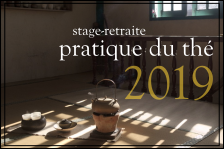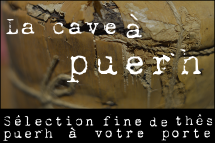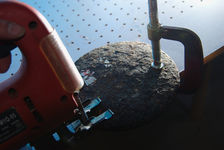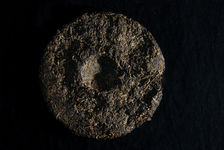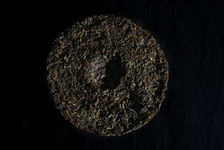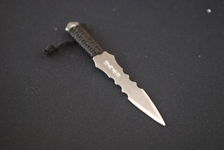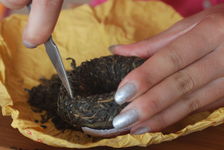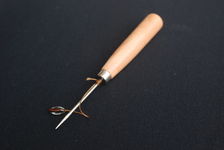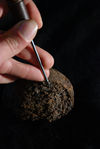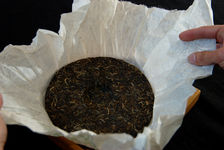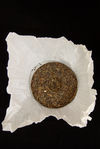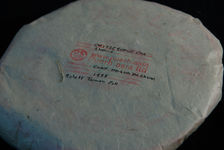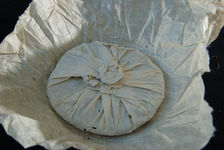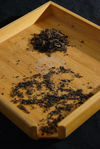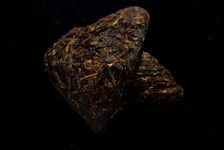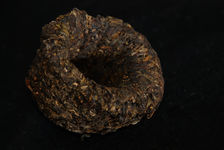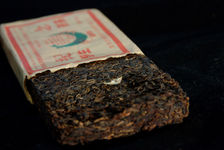 This page is not a real translation but just an automatic translation generated by computer of the original article, written in French language! Its not good... but better than nothing!
This page is not a real translation but just an automatic translation generated by computer of the original article, written in French language! Its not good... but better than nothing!Want to help us do diffuse puerh tea culture in english, by providing a better (or corrected) translation?
Please contact us!

Here's a question that every beginner has posed for a cake, a brick or tuo puerh: how to extract the compressed block is the amount needed to make a tea, without destroying his cake or put anywhere? If this is something that quickly becomes a reflex and that the amateur does not pay attention, the cake is often frightening to the novice who wonders how he will handle the matter, to the point of discouraging some who see something very nice, but probably not practical to make a tea with his breakfast.
The more pragmatic calculate the necessary volume to infuse the whole cake (probably within 12 liters) and throw them into a pot of boiling water, the more violent they will tuo to room with a hammer (do not laugh I heard about monks who did that), others may be tempted by the techniques brute-force , crash test freesby against wall , use the mix, the nearest sharp object (usually a key on his ring taken arbitrarily or oyster knife for the sinner Breton), or alternatively the barbarian who is to take a firm edge of the plate by the palm and then break it into folding the cake, technique performed here and there especially when one wants to display a certain contempt against tea being manipulated. Finally the most skeptical will leave their cake placed on a shelf for fear of damaging it or to take a walk (which by the way this is a good way to let his old cakes for generations to come).
But it is good to remember that if you compress the puerh, it is precisely above all to make its handling, transport and storage practice, and that when you time it right to extract a few grams of a cake is a initiated child's play. In the background there is also no absolute rule and all means are good as they used to extract a few grams of the cake without putting it into play. It means there's yet more practical than others to get there, but mostly friendly one hand to the tea leaves that is extracted, it should not break or shatter under the possible, and secondly for the cake itself, it is desired to maintain a sage later.
Puerh tea does indeed have a great advantage against other products that evolve with time like wine, it's a cake started ages as well as a pancake never opened, and it is thus possible regularly to sample its collection of puerh (Pu Er tea) while preserving them for future years, provided of course be handled carefully. A slab handled carefully can be consumed sparingly for years. Here are some tips to make it happen without trouble.
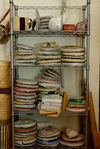
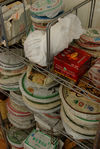
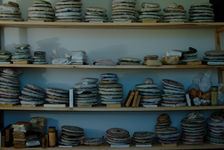
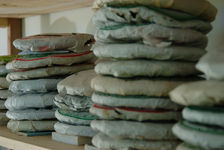
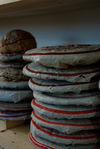
- 1. Cakes started in a cellar puerh (Pu Er tea) personal
- 4. Cakes started in a cellar puerh (Pu Er tea) personal
- 5. Cakes started in a cellar puerh (Pu Er tea) personal
Use a suitable tool
Keep in mind that the purpose of the operation is to extract precise amount you need, without damaging or tea leaves or the slab itself. Generally used for this tea a knife or a peak at tea.
The knife tea is nothing but a thin blade sharpened but not (which does not cut). Specialty stores offer so many Chinese tea knives of various shapes. They are however often very average, both in their design, their completion, see their effectiveness. I highly suggest you take a ride in a good stationery of your city where you will find a wide range of paper cups (this tool less power designed to open the envelope) that will do the trick with a bonus choice and a much higher quality than what the stores offer of tea. The ideal is that the blade is rigid, as thin as possible to its ends, but not cut.
Otherwise if you have nothing else at hand, a simple knife-type small kitchen knife can also do the trick if its blade is not too soft. If it helps out this is not recommended for the long term, the blade of a "real" knife is sharp and therefore tends to spoil the tea leaves.
Another powerful tool (and I personally prefer to use the knife to tea), tea is the peak: a simple metal point. The tip makes it possible to slip between the leaves finely and extract them without damaging them, so finer than is possible the knife.
There as well as shops specializing in tea equipment does not fail, I suggest you rather buy local (to you) and go poking around the hardware store in your neighborhood in search of is called a point or a punch and that is precisely what we seek: a quality metal tip stuck on a handle easy to use. Generally you will find crafts store punches highly enjoyable and better finits (peak stainless steel, wooden handle well shaped, etc.) that suggest that the tea shops.
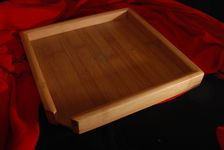
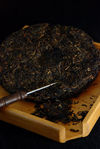
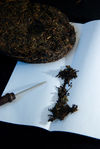
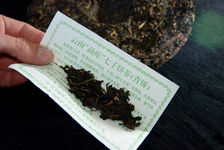
- 1. cake tray
- 2. Use a cake tray
- 3. Use of a single sheet of paper as a tray
- 4. Use of Nei Piao as a tray
Incidentally a cake plate, while not necessary, a friend is very convenient for retracting sheets extracted, and avoid putting in everywhere. Failing any small plate, see a sheet of paper folded in half (Nei Piao of the cake if you have nothing else on hand) will do nicely.
Now that you are equipped, are taking action.
pack and unpack your cake carefully
Ask your cake on the table (or wherever you want) and open the box. Handle wrapping your cake carefully, especially if it's a tea-old (wrapping paper becoming brittle over time) or if you plan to keep this tea a number of years. I refer you to another section dedicated to practice how to properly pack up her cake . Value for teas, old or that you plan to handle regular or long-term, excessive packaging the wafer using a paper puerh (Pu Er tea) quality can be a very good option to protect the original packaging. Most maniacs prefer also keep the original packaging and pack separately they consume tea regularly with papers puerh (Pu Er tea) neutral.
Relax just a few tea leaves
Your cake is fitted on the inside, take advantage of this creu in the middle to insert your knife or your peak in the cake, making it penetrate parallel to the wafer surface. Squeeze the handle of your tool tip to penetrate a few centimeters (depending on the amount of tea you want to extract). Practice then a slight movement of lever to detach a small block of tea that you just have to throw in your teapot or your Gaiwan!
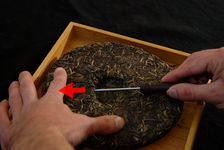
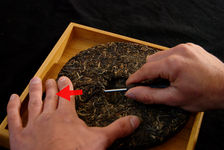
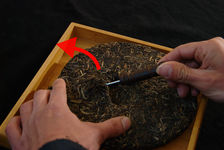
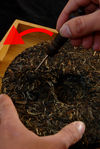
- 1. Push the pix parallel to the surface of the slab
- 2. Gently enter the pix in the body of the plate
- 3. Make a slight movement of a lever to separate the sheets
- 4. Perform a slight movement of the lever to separate the sheets
The cakes are more or less compressed. With practice you will adapt your movement to the situation. A little cake compressed makes it possible to slip between the leaves finely and truly relax one by one without damaging them again to get a loose tea. Conversely, when the cake is compressed, it is impossible to keep every sheet perfectly intact and it should minimize the damage by extracting the most compact one end of the desired amount, which then untie himself in water boiling.
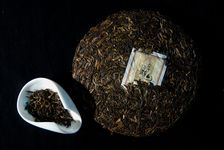
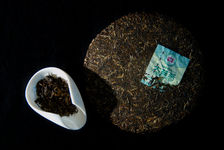
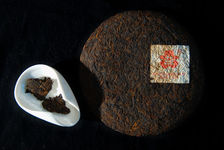
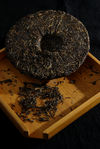
- 1. Slab Detachment little compressed sheet
- 2. Slab detachment in highly compressed sheets
- 3. Slab detachment in highly compressed block
- 4. Slab Detachment little compressed sheet
Overall try to always make progressive movements, horizontal and parallel to the surface, attacking dug over by an area (central hole of the cake, or an area that had already begun earlier). So your cakes will gradually diminish in thickness without losing their shape, which is not only more elegant, allows to pack the patties to the same, but also allows for better development in recent time, maximizing their surface area to air. Sometimes when you unwind and leaves your cake, especially when the latter is highly compressed, that also leaves them even you ended up with a number of crumbs and dust tea. If some people pay with the rest in the pure tea does not spoil, I suggest you instead of throwing the crumbs too fine that may have a negative influence on the aroma of tea and keep only the most beautiful leaves, because finally better spoil a half gram of tea tasting all his ...
Practice the same way for other compressed forms, such as bricks, tuos the jincha (mushrooms), etc. ... Is etched in general square bricks and horizontally by a wafer, and tuos jincha and vertically by the outer surface. Again the idea is to minimize the endomager leaves that are extracted while maintaining the shape of the object.
And why not relax the whole cake at once?
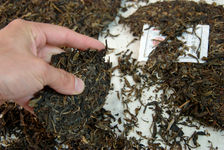
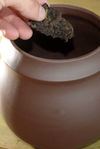
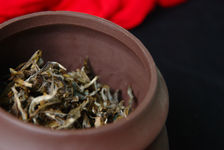
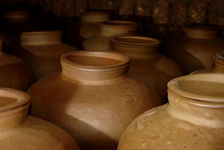
- 1. Getting a piece of cake puerh
- 2. Getting a jar of pancake puerh
- 3. Puerh loose in a jar
- 4. Storage puerh (Pu Er tea) in the jar
Although it is more common to keep its puerh (Pu Er tea) scones, and extract what we need when we need it, which also makes storage easier, another approach is indeed a cake to relax to make the entire bulk, which can then keep in a jar (or container) in which piochera when you need it. For bulking entire wafer is however a specific approach has different advantages and disadvantages and has a real influence on aging tea. This approach will be discussed in a future article, including coverage of specific techniques to bulking a whole cake.
Good tea!

